Cn che bien_sua_7074
1 like186 views
Tài liệu trình bày các khía cạnh chính của một chủ đề cụ thể. Nó cung cấp cái nhìn tổng quát và những thông tin quan trọng liên quan đến vấn đề được đề cập. Nội dung sâu sắc nhưng cô đọng, dễ hiểu.
1 of 168
Download to read offline

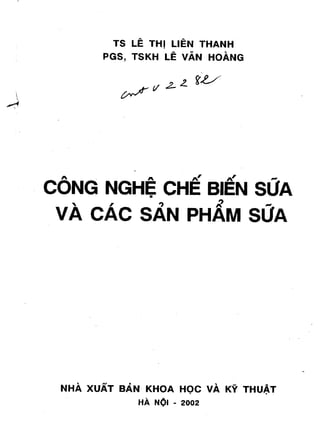
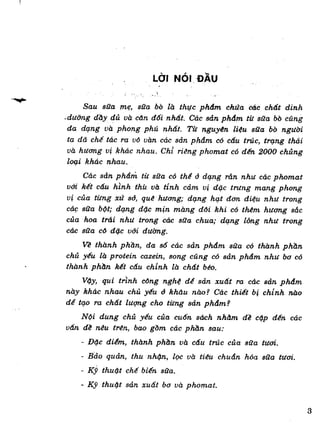
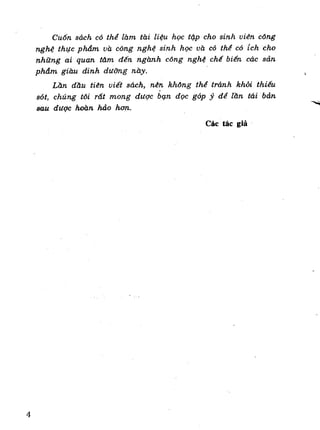
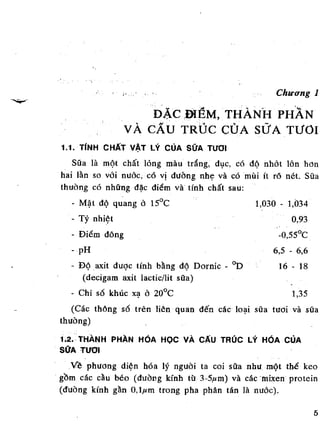
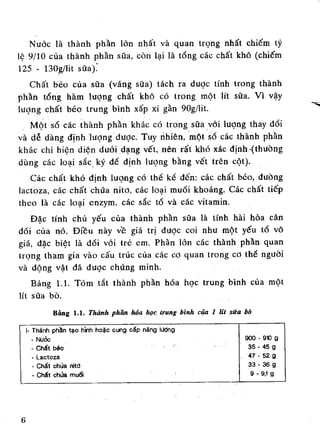
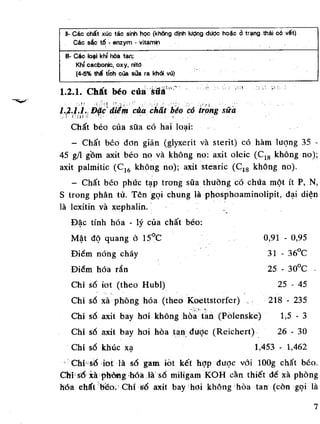

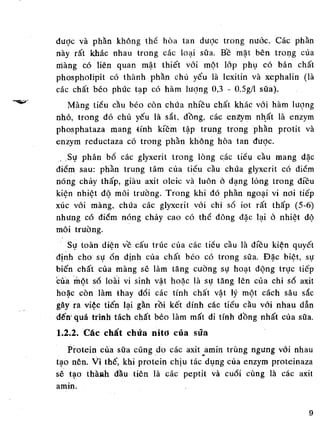
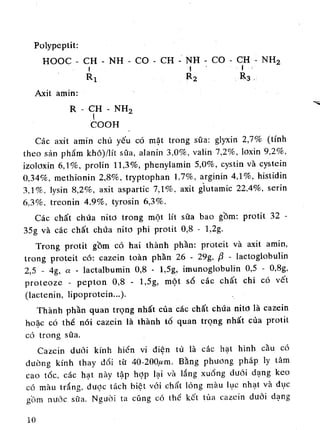
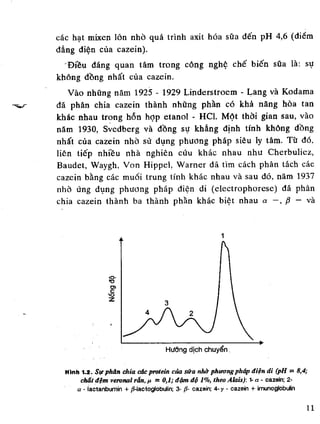
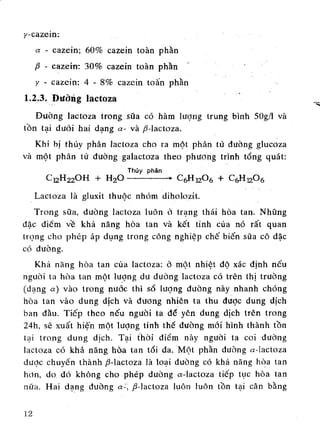
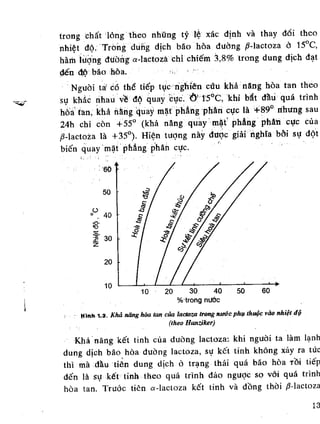
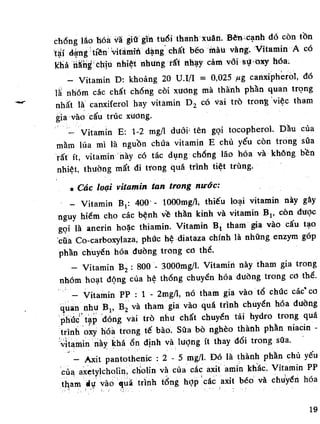
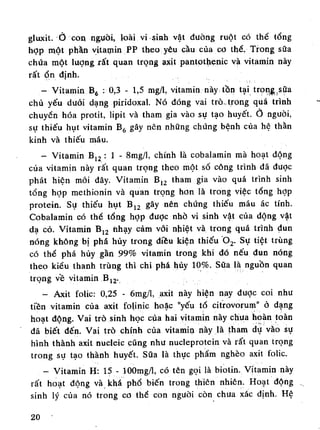

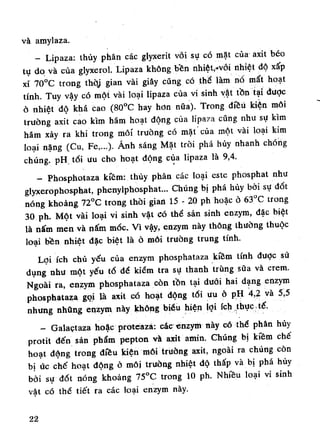
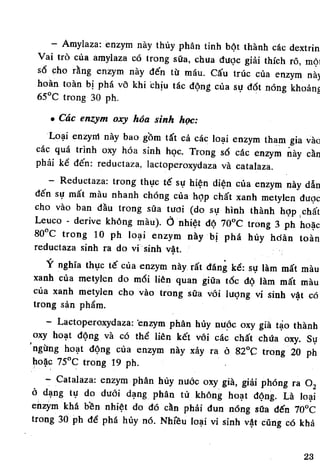
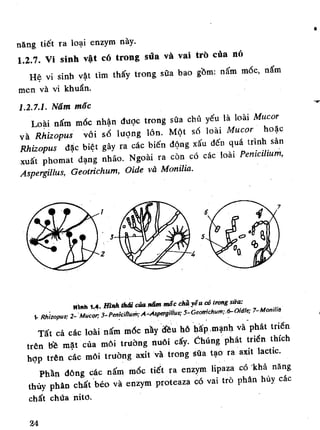
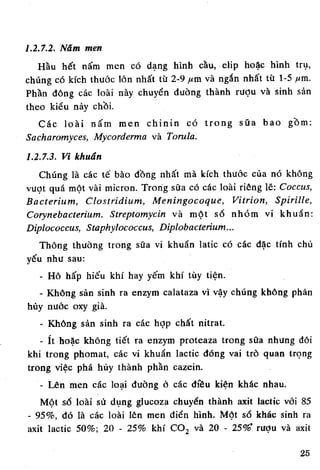
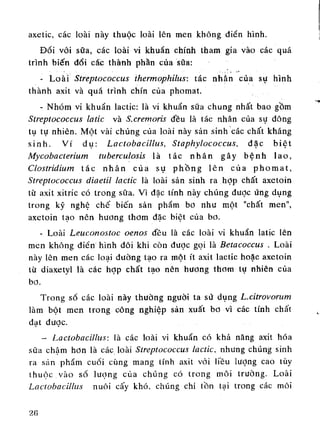
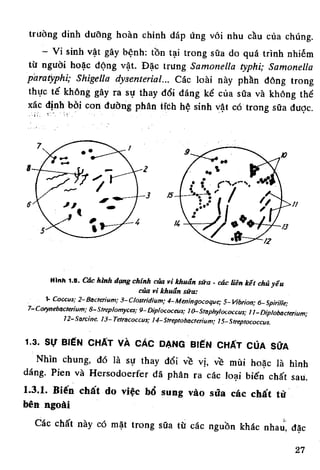
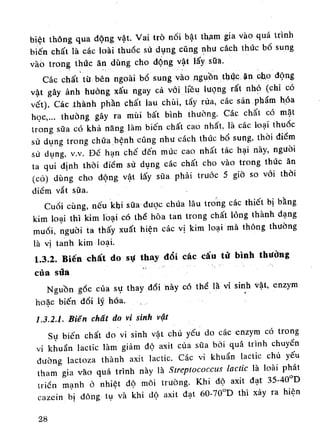



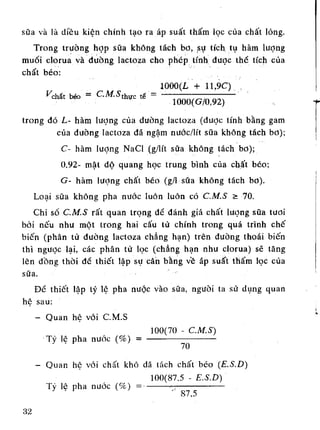

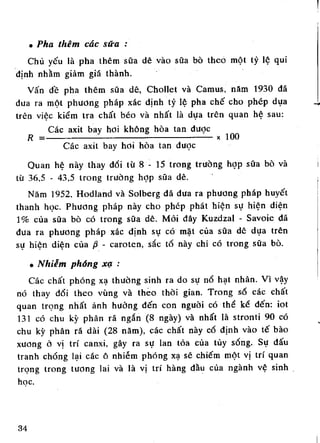
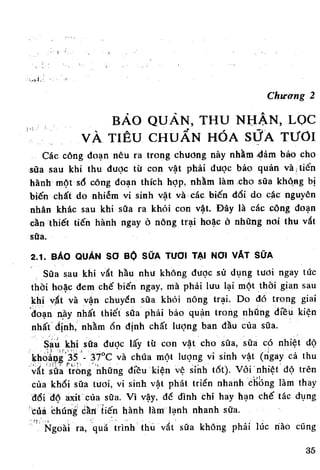
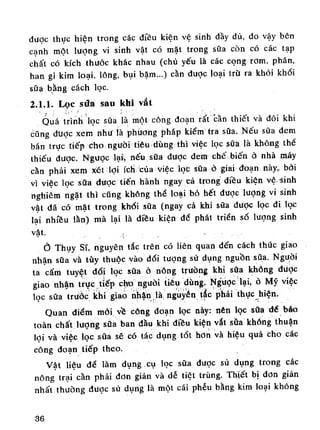
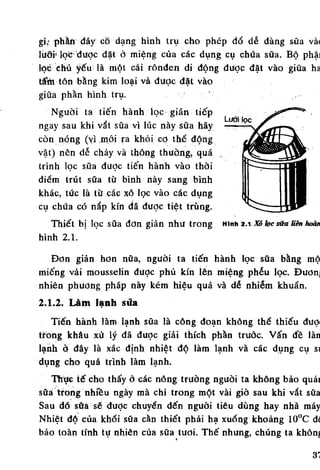
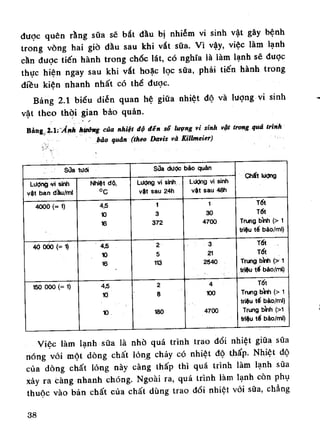

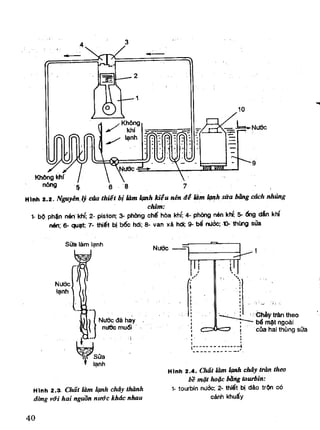
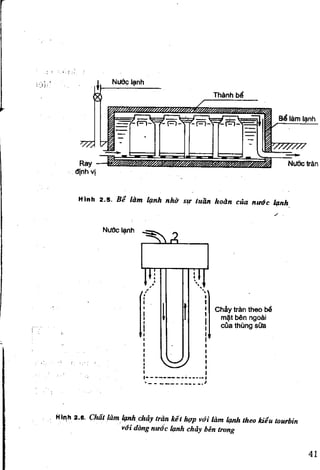
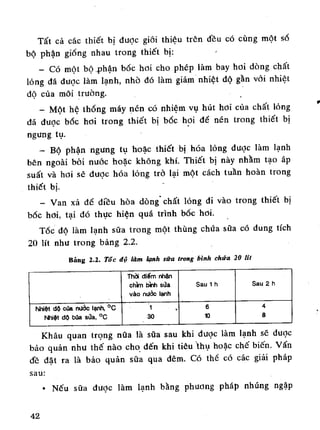
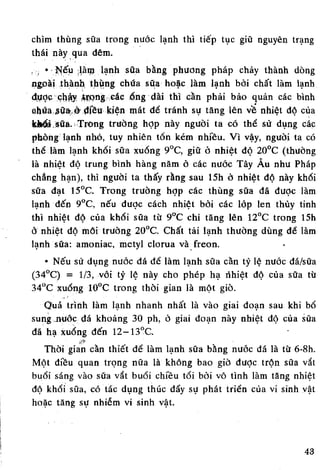
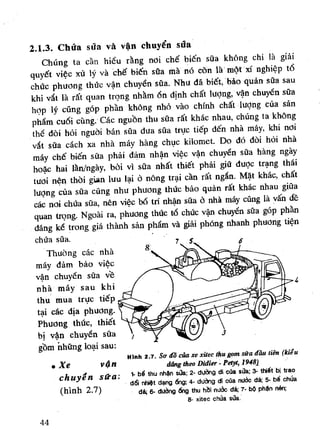
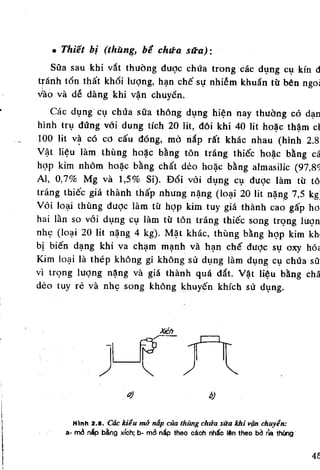
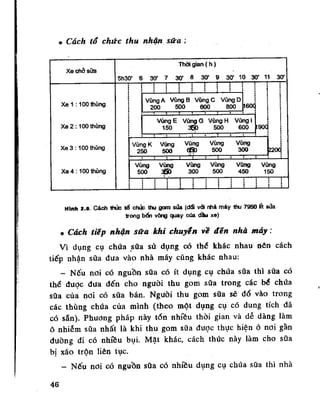

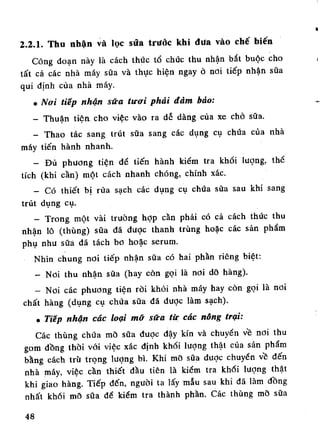
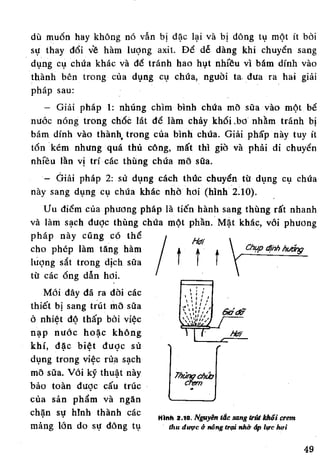

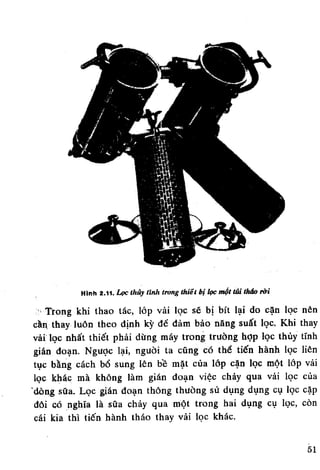
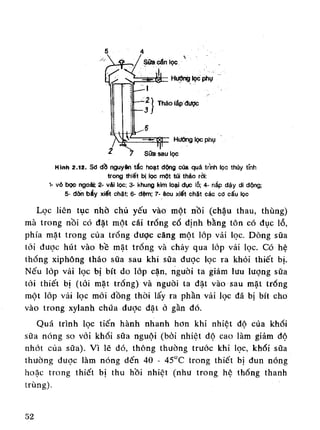
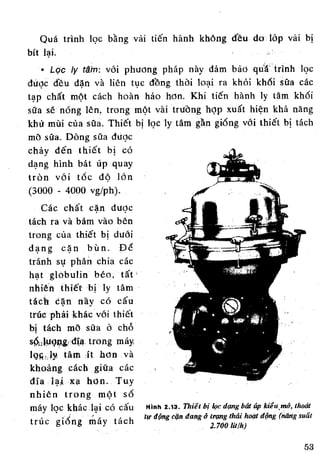




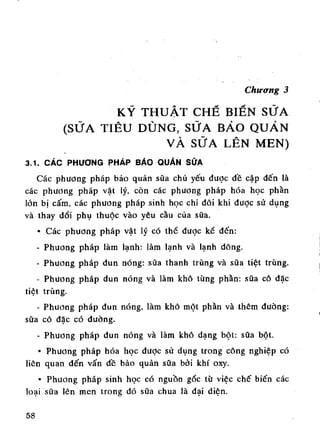
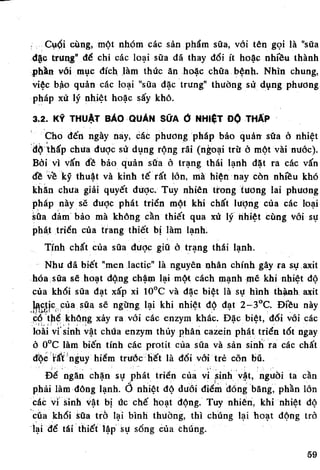

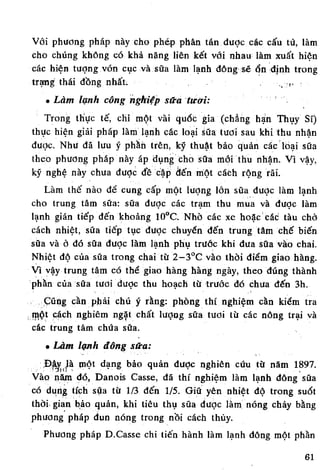
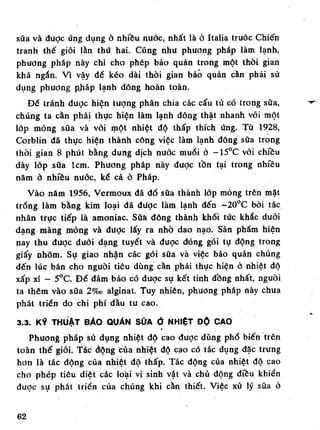
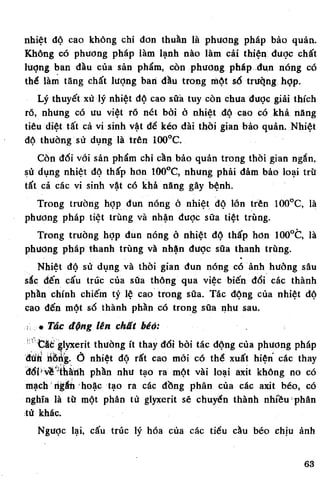

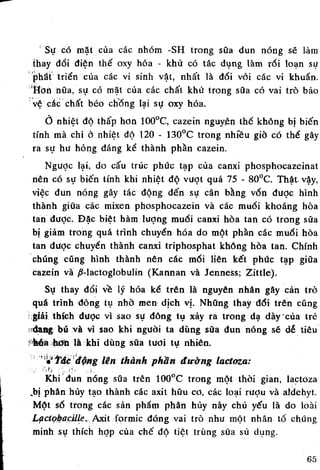
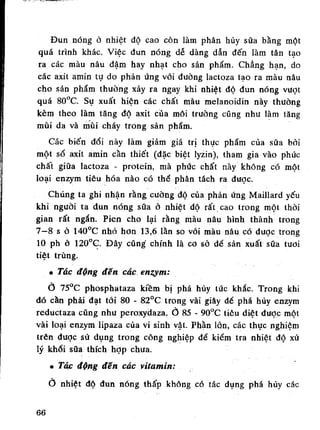
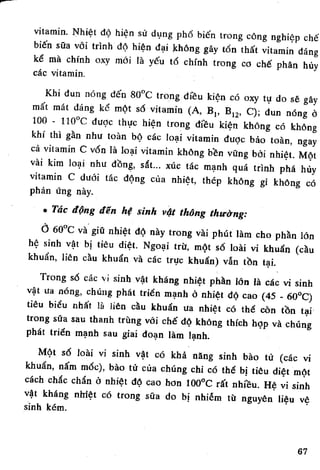
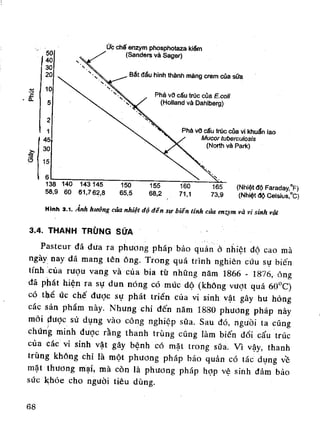
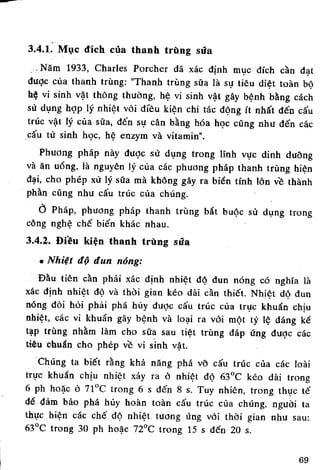
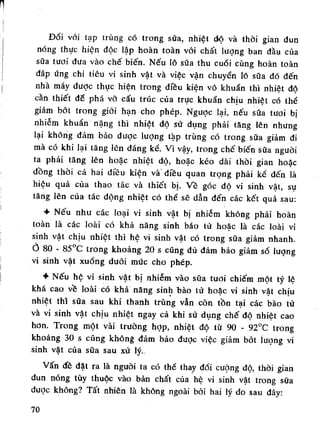



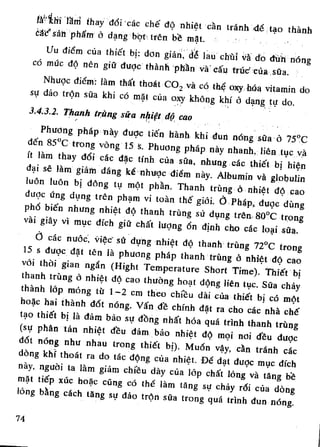



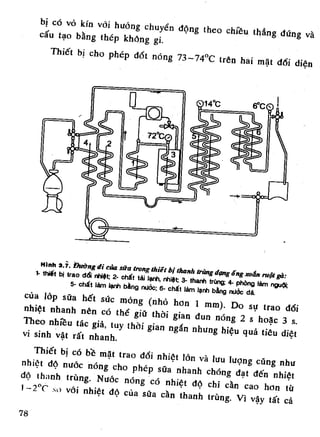
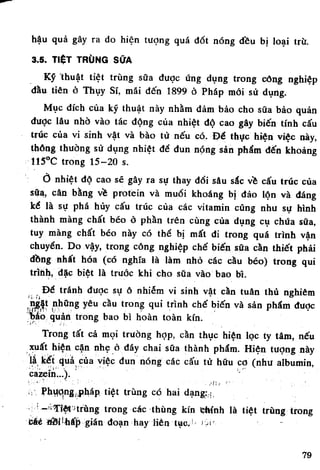
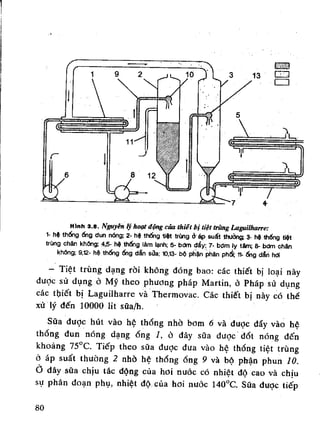
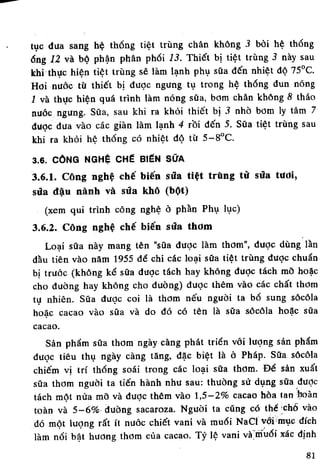

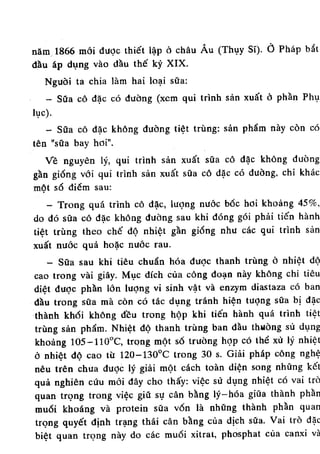
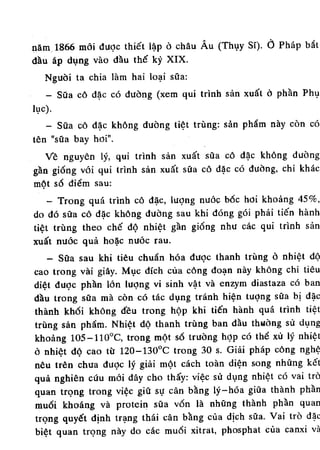
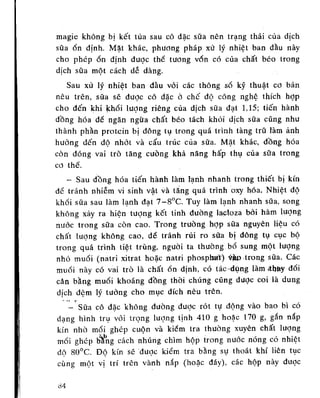
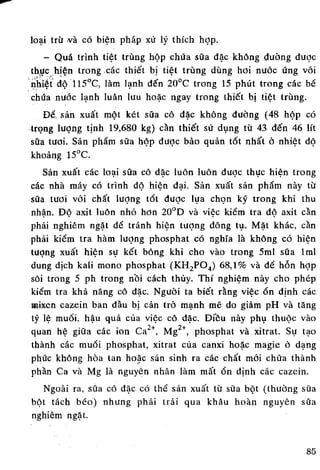

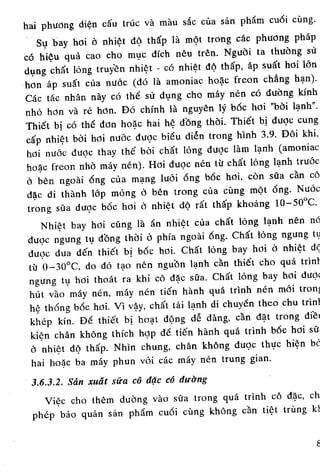
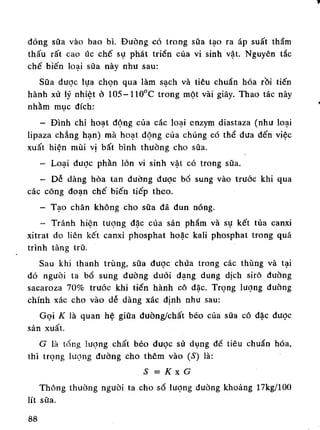

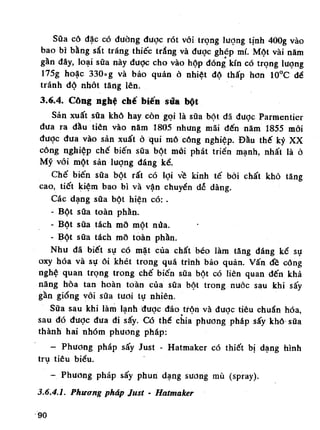
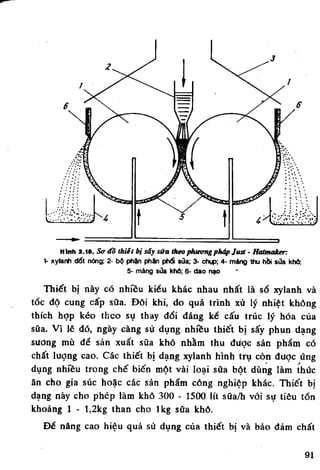

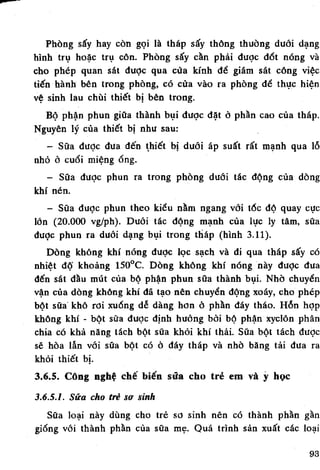
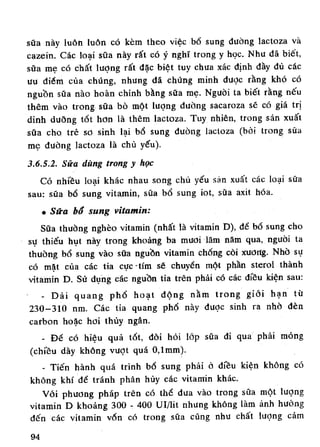
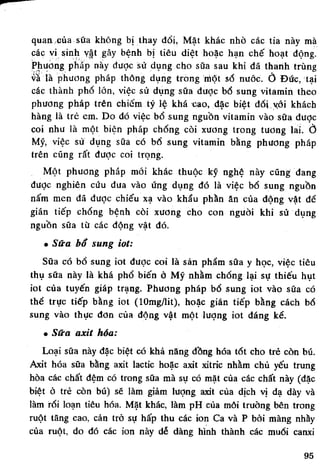
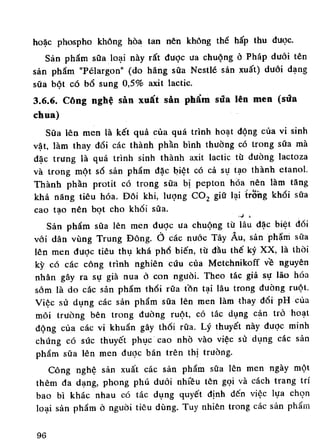
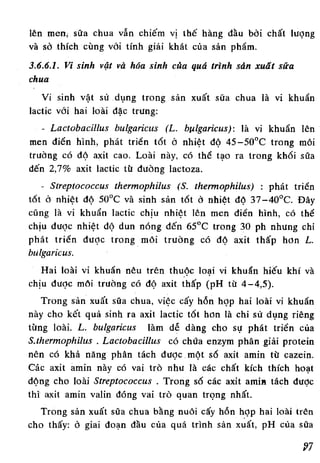
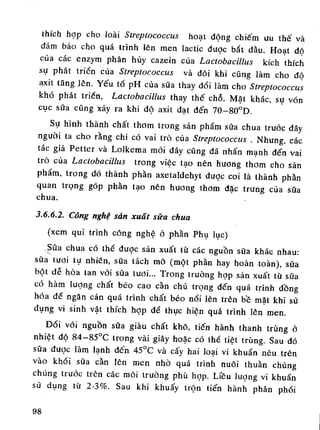

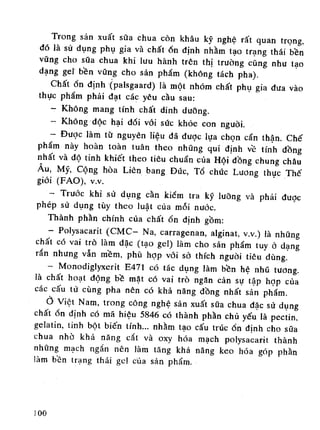
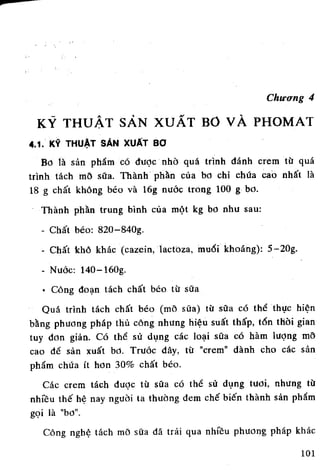
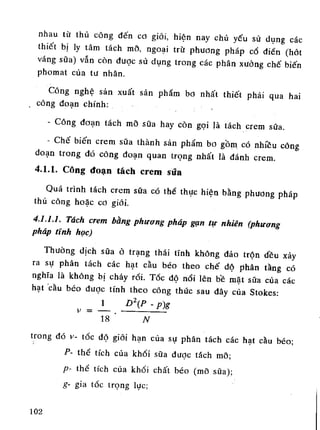
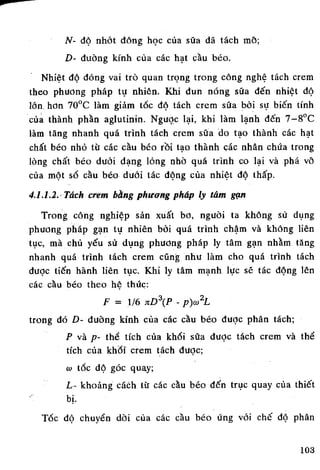

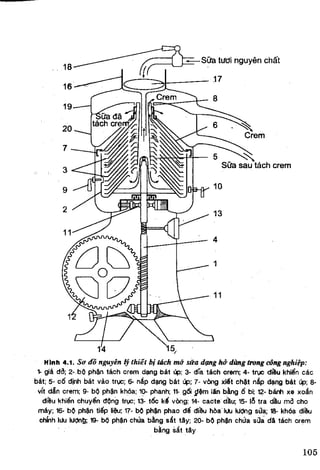
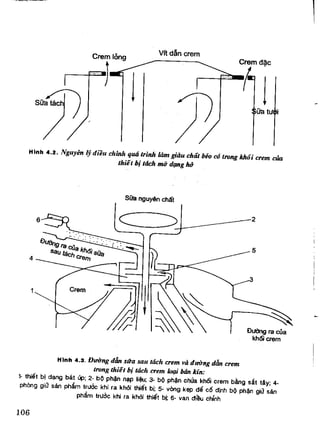
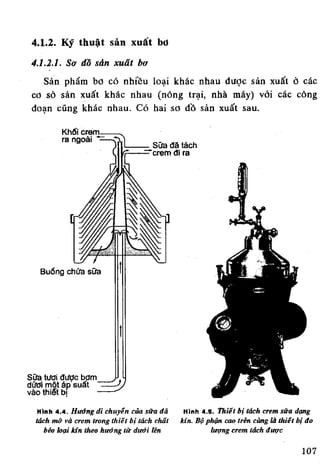


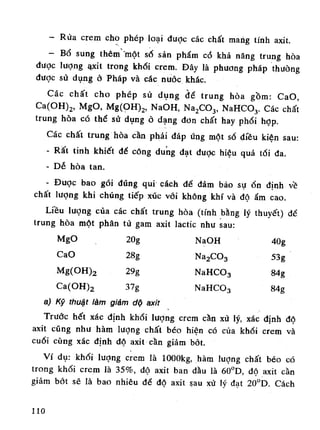

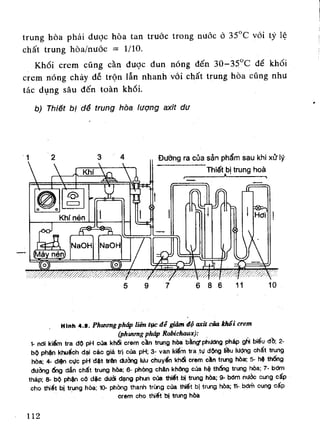
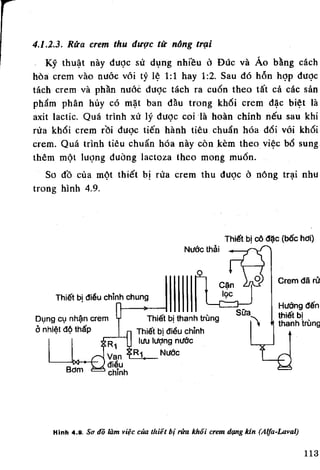
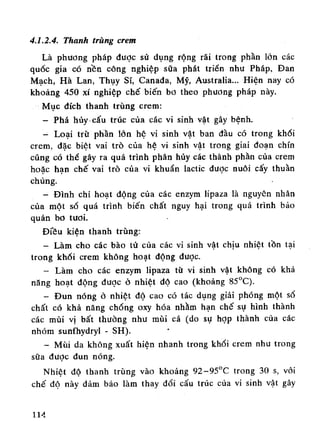
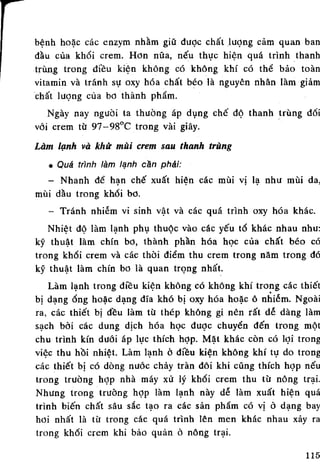

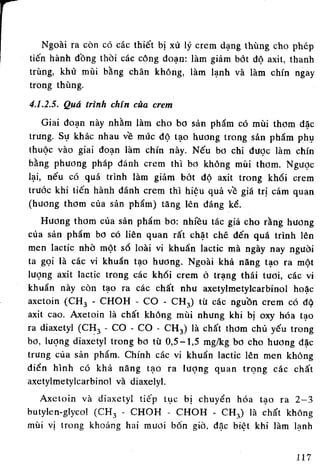
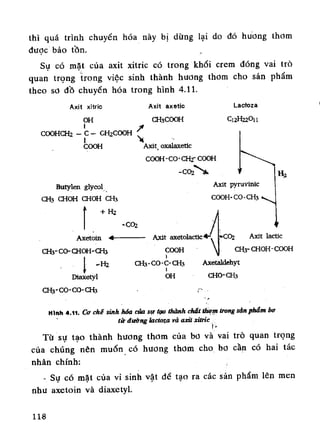

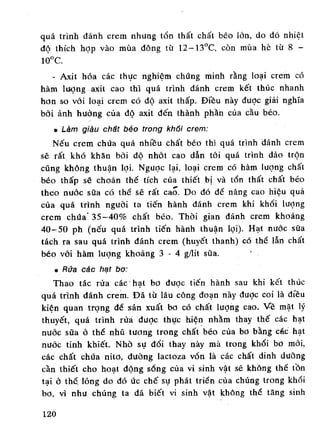
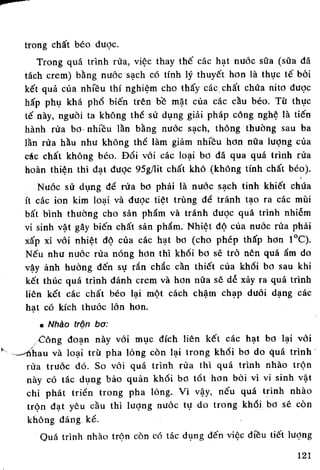

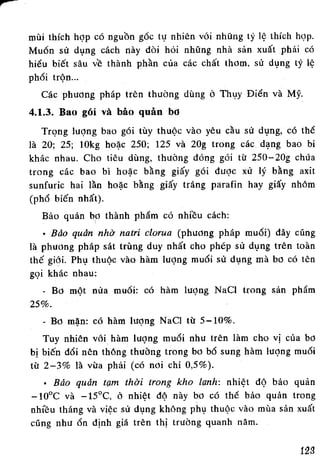


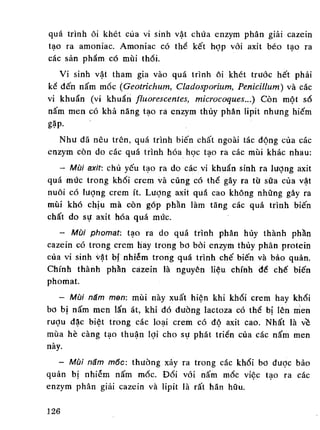



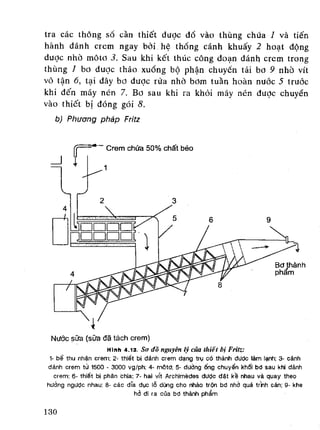
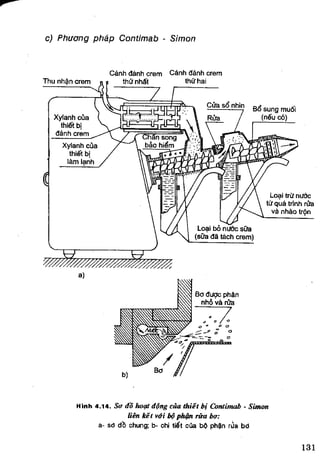
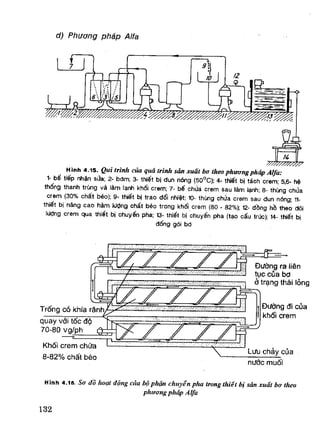

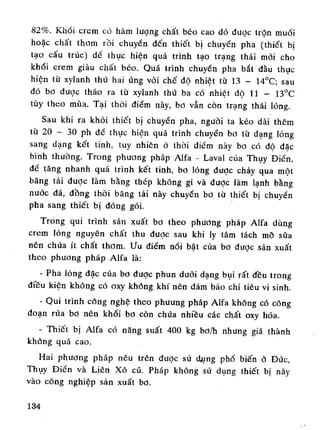
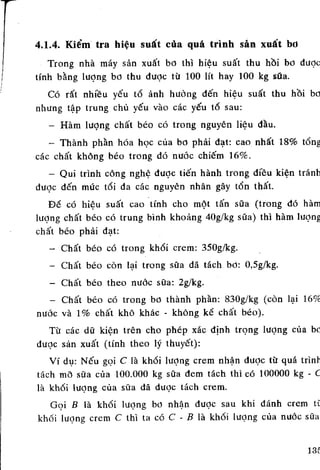
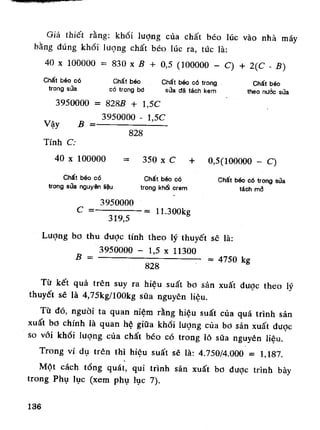

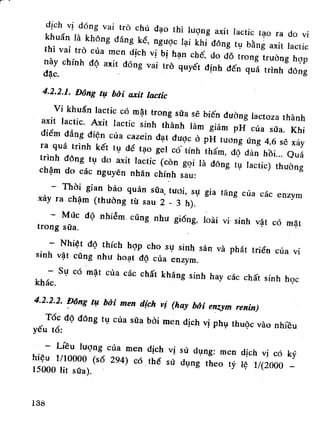
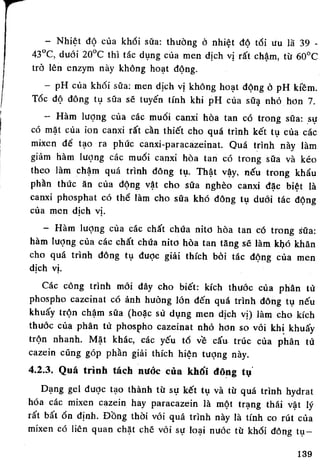

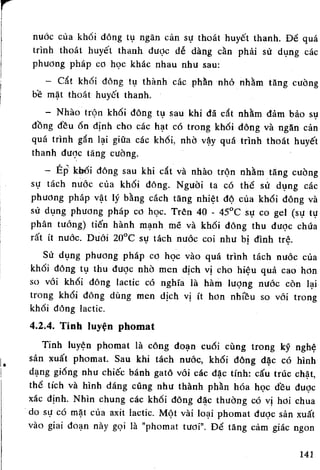
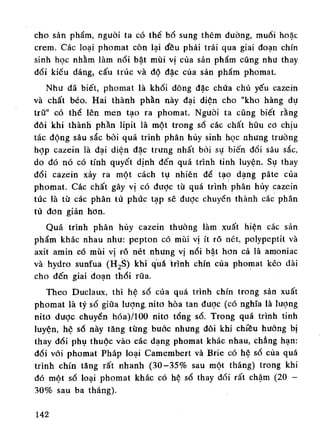
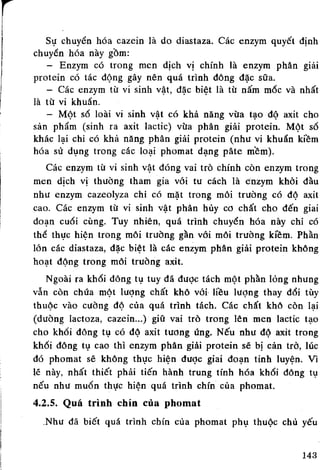
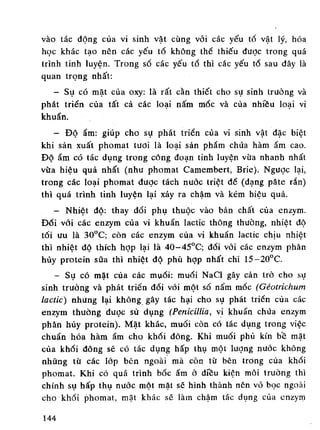
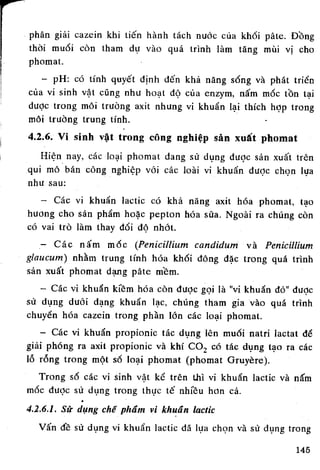
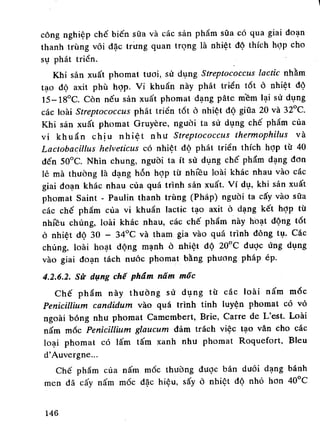
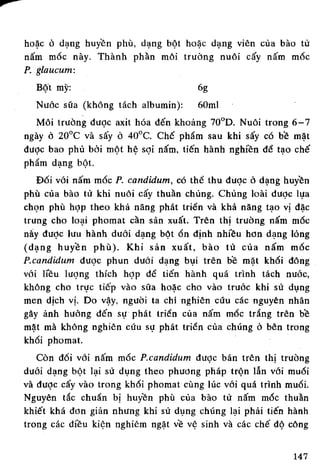


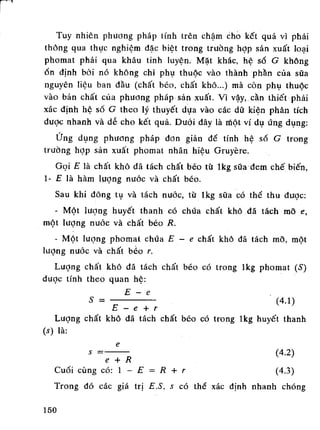

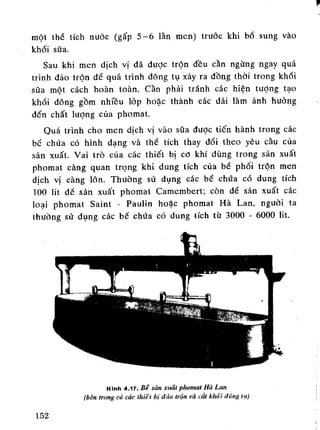


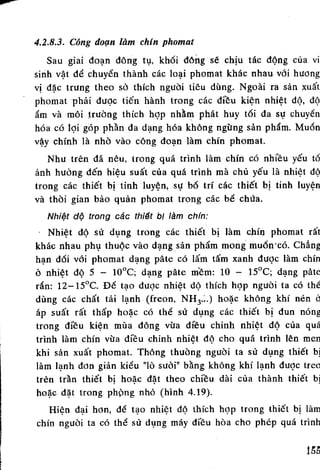
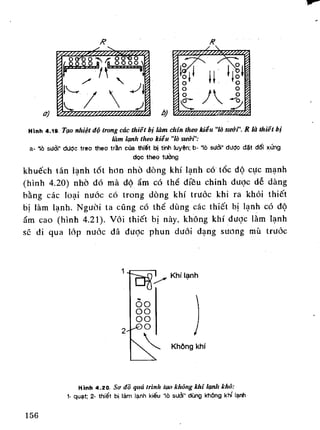
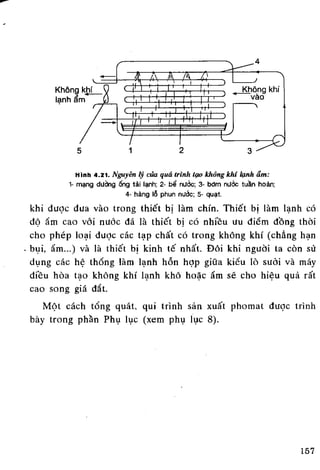

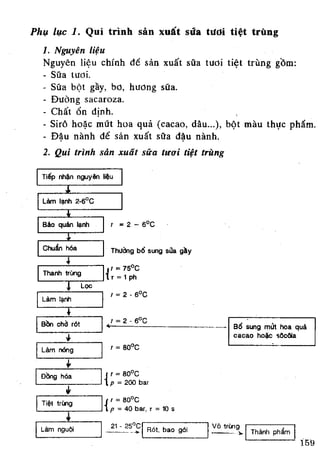
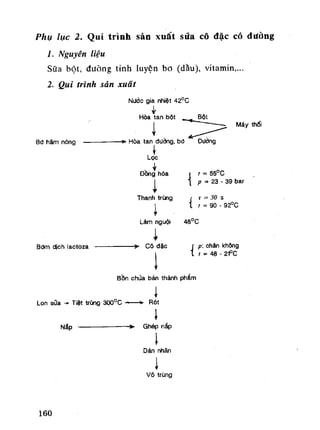
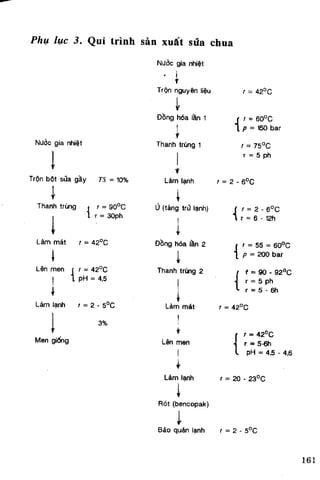


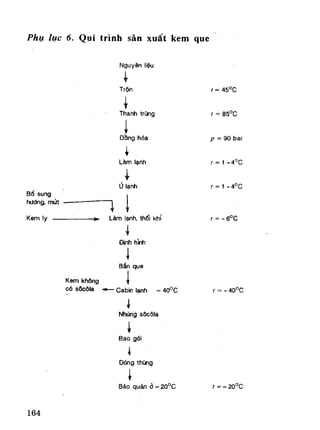
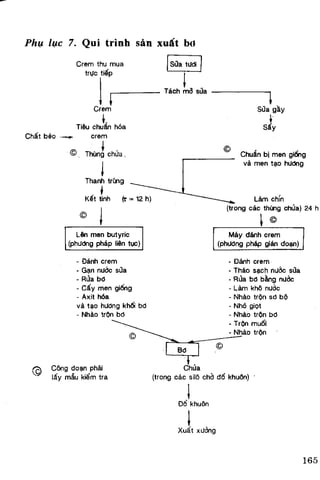
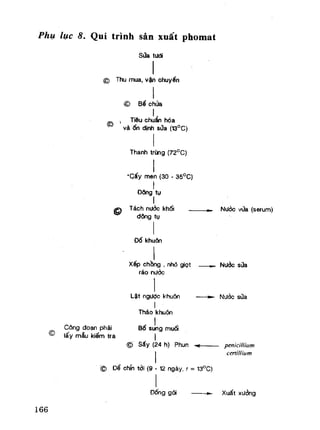

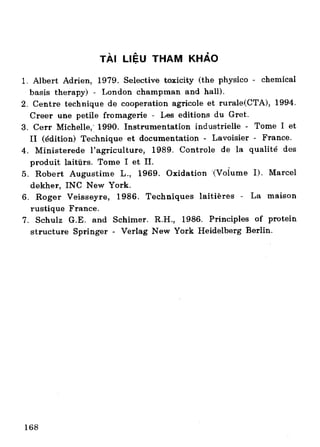

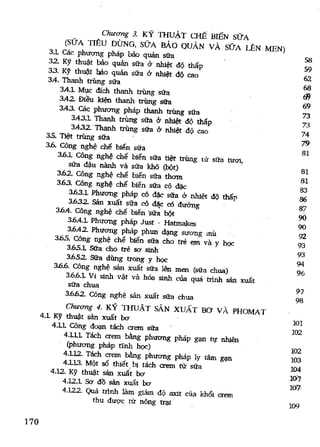


Ad
Recommended
Impact of pulsed light treatment on quality characteristics and oxidative sta...
Impact of pulsed light treatment on quality characteristics and oxidative sta...ljmonking
Ã˝
The study investigates the effects of pulsed light (PL) treatments on fresh-cut avocados regarding microbial stability, color retention, and lipid oxidation over 15 days of refrigerated storage. Higher PL doses effectively reduced microbial counts and maintained better color and chlorophyll retention compared to untreated avocados, while also preventing rancidity and oxidative deterioration of lipids. The findings suggest that PL treatments could enhance the shelf life and quality of fresh-cut avocados without compromising their nutritional value.Stability of avocado paste carotenoids as affected by high hydrostatic pressu...
Stability of avocado paste carotenoids as affected by high hydrostatic pressu...ljmonking
Ã˝
High hydrostatic pressure (HHP) processing is an effective non-thermal method for stabilizing avocado paste carotenoids, resulting in a significant initial increase in total carotenoid concentrations, though levels decline during storage. The study found that while carotenoids contribute minimally to the antioxidant capacity, HHP processed avocado paste retains nutritional value even after 40 days of refrigerated storage. This research highlights the importance of HHP technology for the avocado industry and its potential health benefits.INVESTIGATION ON ISOLATED AND PURIFIED LIPOXYGENASE FROM AVOCADO IN THE PRESE...
INVESTIGATION ON ISOLATED AND PURIFIED LIPOXYGENASE FROM AVOCADO IN THE PRESE...ljmonking
Ã˝
This document describes research on isolating and characterizing lipoxygenase (LOX) enzyme from avocado. Key points:
- LOX was isolated from avocado through a multi-step purification process involving acetone extraction, pH adjustment, salt precipitation, and ultracentrifugation.
- The purified LOX's activity was tested using linolenic acid as a substrate. Its optimum pH was found to be 6.5 and optimum temperature was 40°C.
- Kinetic parameters Km and Vmax for LOX were determined using the Lineweaver-Burk method with varying linolenic acid concentrations. Characterization of avocado LOX could help minimize its detrimental effects onGUACAMOLE AND AVOCADO PRODUCTS
GUACAMOLE AND AVOCADO PRODUCTS ljmonking
Ã˝
This document discusses how high pressure processing (HPP) can be used to preserve guacamole and avocado products. HPP uses high water pressure (typically 600 MPa for 3 minutes) to inactivate microorganisms without affecting nutritional quality or sensory attributes. HPP allows for longer shelf life by controlling spoilage bacteria and pathogens. It also partially inactivates enzymes responsible for browning and off-flavors. Proper refrigerated storage after HPP is necessary to minimize quality changes from residual enzyme activity over time.De thi va bai giai olympic toan (1993 2005)
De thi va bai giai olympic toan (1993 2005)ljmonking
Ã˝
This document provides sample questions and solutions from the Vietnamese National Olympiad in Mathematics competitions from 1993 to 2005. It contains 3 or fewer sentences summarizing each section:
The first section presents problems and solutions from the 1993 competition, including problems on systems of linear equations and inequalities, properties of quadratic functions, and factorization of polynomials. The second section covers problems on linear systems, quadratic functions, and properties of trigonometric functions from the 1994 competition. The third section discusses problems involving linear systems, properties of quadratic functions, and factorization from the 1995 competition.Avocado paste carotenoids
Avocado paste carotenoids ljmonking
Ã˝
HHP processing of avocado paste at 600 MPa for 3 minutes significantly increased total extractable carotenoid levels by about 56%. During storage of the processed paste for 40 days at 4°C, carotenoid levels declined but remained higher than in unprocessed paste. ORAC values, a measure of antioxidant capacity, decreased after processing but increased during storage, indicating carotenoids contribute minimally to total antioxidant capacity. The study showed HHP processing and refrigerated storage retained avocado carotenoids and bioactive compounds within the product's sensory shelf life.Cac phuong phap giai pt ham thuong dung
Cac phuong phap giai pt ham thuong dungljmonking
Ã˝
Tài liệu trình bày các phương pháp giải phương trình hàm với nhiều ví dụ khác nhau, tập trung vào việc xác định các hàm số thỏa mãn các điều kiện nhất định. Các ví dụ minh họa sử dụng nhiều loại hàm số khác nhau và cách tìm nghiệm của chúng, từ hàm số tuyến tính cho đến hàm bậc cao. Thông qua các phương trình cụ thể, tài liệu cũng chỉ ra cách khẳng định tính duy nhất của các hàm số đã tìm được.13 ki-thuat-giai-phuong-trinh-ham (1)
13 ki-thuat-giai-phuong-trinh-ham (1)ljmonking
Ã˝
Tài liệu trình bày các phương pháp giải phương trình hàm, bao gồm phương pháp thế biến, quy nạp, và khai thác các tính chất của hàm số như đơn ánh, toàn ánh và chẵn lẻ. Nó cung cấp nhiều ví dụ cụ thể cùng với hướng dẫn chi tiết để giải quyết các bài toán liên quan đến phương trình hàm. Các ứng dụng và kiến thức khác về hàm tuần hoàn và bất đẳng thức cũng được thảo luận.Nghiên cứu một số đặc điểm sinh lí, hóa sinh và năng suất một số giống dưa ch...
Nghiên cứu một số đặc điểm sinh lí, hóa sinh và năng suất một số giống dưa ch...ljmonking
Ã˝
Nghiên cứu một số đặc điểm sinh lí, hóa sinh và năng suất một số giống dưa chuột lai f1 (cucumis sativus l) trồng tam dương vĩnh phúcNghiên cứu thành phần hóa học cây chanh leo tím
Nghiên cứu thành phần hóa học cây chanh leo tímljmonking
Ã˝
Đề tài này nghiên cứu thành phần hóa học của cây chanh leo tím (Passiflora edulis Sims), nhằm xác định các nhóm chất có trong lá và vỏ quả bằng phản ứng hóa học, cũng như phân lập và định lượng một số hợp chất như flavonoid và chất béo. Nghiên cứu cũng đề cập đến ứng dụng y học của chanh leo tím, bao gồm tác dụng an thần và điều trị một số bệnh liên quan. Các kết quả và phương pháp nghiên cứu được trình bày chi tiết trong các phần thực nghiệm và bàn luận.Studies on certain quality attributes of meat pickle prepared from spent chicken
Studies on certain quality attributes of meat pickle prepared from spent chickenljmonking
Ã˝
This document summarizes a study on the quality attributes of meat pickle prepared from spent chicken meat. Spent chicken meat was marinated, pressure cooked, fried with spices, and packed in jars. The pickle was analyzed over 90 days of storage at room temperature. Key findings:
1) The pickle had 61.89% moisture, 17.28% protein, 14.65% fat, and 3.35% ash. pH and mold counts did not differ significantly during storage but TBA values and bacterial counts increased significantly over time.
2) Sensory analysis found decreasing scores for color, flavor, and overall acceptance during storage, though texture and juiciness did not differ significantly.
3) ThePassion fruit
Passion fruitljmonking
Ã˝
This document provides information on passion fruit, including its origin, description, cultivation requirements, propagation methods, pests and diseases, harvesting, and popular cultivars. It describes passion fruit as a climbing vine native to South America that produces oval or round fruits containing pulp and seeds. The document outlines ideal growing conditions for passion fruit such as full sun, well-draining soil, regular watering and fertilizing, and protection from frost. It also discusses pruning, propagation from seed or cuttings, and common pests and diseases afflicting passion fruit vines.Cold plasma final_fp_for_pure
Cold plasma final_fp_for_pureljmonking
Ã˝
This document summarizes a study that investigated the use of atmospheric cold plasma to decontaminate radicchio (red chicory) leaves. The researchers treated radicchio leaves with cold plasma for 15 or 30 minutes. They then analyzed the effects on microbial reduction, antioxidant activity, and quality attributes over several days of storage. They found that a 15-minute treatment significantly reduced E. coli levels, while a 30-minute treatment was needed to significantly reduce L. monocytogenes. The antioxidant activity and quality of the radicchio were maintained after cold plasma treatment. The study suggests cold plasma may be a promising non-thermal method for decontaminating leafy vegetables while preserving quality and nutritional properties.Cong nghe do hop thuc pham va gia suc gia cam nguyen trong can
Cong nghe do hop thuc pham va gia suc gia cam nguyen trong canljmonking
Ã˝
Tài liệu này nêu rõ tầm quan trọng của việc quản lý thời gian hiệu quả. Nó cung cấp các chiến lược và phương pháp giúp cá nhân nâng cao năng suất. Nội dung cũng bao gồm những thử thách thường gặp và cách khắc phục chúng.Phuv vis-140428015232-phpapp01
Phuv vis-140428015232-phpapp01ljmonking
Ã˝
Tài liệu này trình bày về phương pháp phổ UV-Vis, bao gồm các khái niệm cơ bản về vùng phổ, sự hấp thụ ánh sáng và các chuyển dịch điện tử trong hợp chất hữu cơ. Nó cũng đề cập đến các yếu tố ảnh hưởng đến bước sóng hấp thụ và mô tả các hệ thống thiết bị quang phổ UV-Vis cùng với ứng dụng trong phân tích thực phẩm. Đặc biệt, định luật Lambert-Beer được nhấn mạnh như là cơ sở cho việc định lượng trong phân tích quang học.Kỹ thuật sấy nông sản thực phẩm
Kỹ thuật sấy nông sản thực phẩmljmonking
Ã˝
Giáo án kỹ thuật sấy nông sản thực phẩm trình bày về các loại nguyên liệu ẩm và phân loại theo quan điểm hóa lý, bao gồm vật liệu keo, xốp mao dẫn, và keo xốp mao dẫn. Tài liệu cũng mô tả các dạng liên kết và đặc trưng trạng thái ẩm của vật liệu trong quá trình sấy, cùng với các tác nhân sấy như không khí và khói, bao gồm các thông số cơ bản liên quan đến áp suất, nhiệt độ và độ ẩm.An toan thuc pham phan tich vsv
An toan thuc pham phan tich vsvljmonking
Ã˝
Tài liệu mô tả các phương pháp phân tích vi sinh vật trong mẫu, bao gồm phương pháp phân tích chỉ tiêu tsvkhk, e.coli, coliforms và salmonella. Các phương pháp này dựa trên việc cấy mẫu vào môi trường nuôi cấy và theo dõi sự phát triển của khuẩn lạc để xác định số lượng vi sinh vật có trong mẫu. Các kết quả được tính toán và biểu diễn dưới dạng trị số cfu hoặc mpn trong 1g hoặc 1ml mẫu ban đầu.Sự hấp phụ khí và hơi trên chất hấp phụ rắn
Sự hấp phụ khí và hơi trên chất hấp phụ rắnljmonking
Ã˝
Sự hấp phụ khí và hơi trên chất hấp phụ rắn được mô tả thông qua các phương trình hấp phụ đẳng nhiệt như Langmuir và Freundlich, với các đặc điểm cơ bản khác nhau giữa hấp phụ đơn lớp và đa lớp. Langmuir mô hình hóa hấp phụ trên bề mặt đồng nhất, trong khi Freundlich áp dụng cho các trường hợp không đồng nhất và có thể thiết lập được các hằng số từ thực nghiệm. Thuyết BET mở rộng việc mô tả quá trình hấp phụ đa lớp, cung cấp công thức để xác định một số thông số quan trọng như thể tích và bề mặt của chất hấp phụ.kĩ thuật phân tích cảm quan thực phẩm (hà duy tư)
kĩ thuật phân tích cảm quan thực phẩm (hà duy tư)ljmonking
Ã˝
Tài liệu này đề cập đến các xu hướng mới trong công nghệ thông tin và cách chúng ảnh hưởng đến doanh nghiệp. Nó nhấn mạnh tầm quan trọng của việc ứng dụng công nghệ để nâng cao hiệu quả hoạt động. Cuối cùng, tài liệu đưa ra một số khuyến nghị cho các tổ chức để thích nghi với sự thay đổi này.Bai7 khai trien_taylor
Bai7 khai trien_taylorljmonking
Ã˝
Tài liệu trình bày công thức khai triển Taylor và các phần dư Lagrange cũng như Peano, cùng với ví dụ minh họa cụ thể cho việc khai triển các hàm số như sin, tan và các đa thức. Tài liệu giải thích ý nghĩa của khai triển Taylor trong việc đơn giản hóa tính toán với các hàm phức tạp thông qua các đa thức. Nó cũng đề cập đến các phương pháp khai triển đến cấp độ khác nhau và cách áp dụng chúng trong các trường hợp cụ thể.A not-a
A not-aljmonking
Ã˝
Tài liệu mô tả cách phân tích kết quả thử nghiệm sử dụng kiểm định thống kê chi bình phương (2) để so sánh sự lựa chọn giữa hai mẫu sản phẩm. Kết quả thử nghiệm cho thấy rằng hai sản phẩm, một có 30% gạo và một có 25% gạo, không khác nhau về chất lượng ở mức ý nghĩa 5%. Phân tích kết quả dựa trên số lượng người tham gia và các giá trị quan trắc cùng giá trị kỳ vọng.Www.mathvn.com cttq-dayso-tran duyson
Www.mathvn.com cttq-dayso-tran duysonljmonking
Ã˝
Tài liệu trình bày về việc tìm công thức tổng quát cho các dãy số, nhấn mạnh tầm quan trọng của dãy số trong toán học và các ứng dụng trong đời sống. Các ví dụ minh họa phương pháp chứng minh và tìm công thức tổng quát cho một số dãy số cơ bản, bao gồm dãy Fibonacci. Tài liệu cũng cung cấp phương pháp tiếp cận tổng quát cho các bài toán liên quan đến dãy số, cùng với những công thức cụ thể cho từng trường hợp.Say ca tra bang nang luong mat troi
Say ca tra bang nang luong mat troiljmonking
Ã˝
Quá trình chế biến cá bao gồm các bước ngâm, xát muối, rửa muối, sấy khô và đóng gói, với thời gian ngâm từ 28-32h và ướp muối trong 3-4h. Các phương pháp sấy cá gồm phơi nắng, sấy năng lượng mặt trời và sấy bằng lò điện, trong đó sấy năng lượng mặt trời có thời gian và chất lượng tốt nhất. Mục tiêu cuối cùng là đạt độ ẩm từ 35-45% để đảm bảo chất lượng sản phẩm.Công nghệ chế biến thực phẩm đóng hộp
Công nghệ chế biến thực phẩm đóng hộpljmonking
Ã˝
Tài liệu cung cấp thông tin chi tiết về công nghệ chế biến thực phẩm đóng hộp, bao gồm các quá trình chế biến sơ bộ nguyên liệu như lựa chọn, làm sạch, làm nhỏ, và các kỹ thuật chế biến đồ hộp khác nhau. Nó cũng đề cập đến quá trình thanh trùng, tiêu chuẩn đồ hộp và các phương pháp sử dụng trong ngành công nghiệp thực phẩm để đảm bảo sản phẩm chất lượng cao và an toàn. Tài liệu là nguồn tài liệu tham khảo quan trọng cho những ai quan tâm đến công nghệ chế biến thực phẩm đóng hộp.Truyện giết con chim nhại
Truyện giết con chim nhạiljmonking
Ã˝
Chương 1 miêu tả sự phát triển của nhân vật Jem sau khi gặp tai nạn gãy tay, và sự hình thành một mối quan hệ đầy kịch tính giữa Jem, Scout và bạn mới Dill, người đã kích thích trí tưởng tượng của họ về Boo Radley. Câu chuyện cũng đưa ra bối cảnh lịch sử gia đình Finch và mối liên hệ của họ với thị trấn Maycomb, nơi cha của Scout, Atticus, làm luật sư. Các sự kiện diễn ra trong mùa hè thú vị khi Dill tham gia vào cuộc sống của Jem và Scout, nhấn mạnh mối quan tâm đến ngôi nhà Radley bí ẩn.Truyện hoàng tử bé
Truyện hoàng tử béljmonking
Ã˝
Cuốn sách kể về cuộc gặp gỡ giữa một phi công và một cậu bé thần kỳ, người đến từ một tiểu hành tinh nhỏ bé. Cậu bé yêu cầu phi công vẽ một con cừu, và từ cuộc trò chuyện, phi công dần khám phá ra tâm tư và thế giới phong phú phía sau cậu bé. Qua đó, tác giả đặt ra nhiều câu hỏi về sự ngây thơ của trẻ con so với thế giới người lớn, những điều thường bị bỏ qua hoặc không được coi trọng.đột phá trong học tập
đột phá trong học tậpljmonking
Ã˝
Cuốn sách của Phạm Đình Tuấn trình bày những bí quyết để đạt được thành công trong học tập và cuộc sống, nhấn mạnh tầm quan trọng của tư duy và sự tự tin. Tác giả khuyến khích độc giả giải phóng tiềm năng bản thân, không bị ràng buộc bởi hoàn cảnh xuất phát. Ngoài ra, cuốn sách cũng đề cập đến vai trò của động lực, đam mê và sứ mệnh cá nhân trong việc hướng tới thành công.More Related Content
More from ljmonking (20)
Nghiên cứu một số đặc điểm sinh lí, hóa sinh và năng suất một số giống dưa ch...
Nghiên cứu một số đặc điểm sinh lí, hóa sinh và năng suất một số giống dưa ch...ljmonking
Ã˝
Nghiên cứu một số đặc điểm sinh lí, hóa sinh và năng suất một số giống dưa chuột lai f1 (cucumis sativus l) trồng tam dương vĩnh phúcNghiên cứu thành phần hóa học cây chanh leo tím
Nghiên cứu thành phần hóa học cây chanh leo tímljmonking
Ã˝
Đề tài này nghiên cứu thành phần hóa học của cây chanh leo tím (Passiflora edulis Sims), nhằm xác định các nhóm chất có trong lá và vỏ quả bằng phản ứng hóa học, cũng như phân lập và định lượng một số hợp chất như flavonoid và chất béo. Nghiên cứu cũng đề cập đến ứng dụng y học của chanh leo tím, bao gồm tác dụng an thần và điều trị một số bệnh liên quan. Các kết quả và phương pháp nghiên cứu được trình bày chi tiết trong các phần thực nghiệm và bàn luận.Studies on certain quality attributes of meat pickle prepared from spent chicken
Studies on certain quality attributes of meat pickle prepared from spent chickenljmonking
Ã˝
This document summarizes a study on the quality attributes of meat pickle prepared from spent chicken meat. Spent chicken meat was marinated, pressure cooked, fried with spices, and packed in jars. The pickle was analyzed over 90 days of storage at room temperature. Key findings:
1) The pickle had 61.89% moisture, 17.28% protein, 14.65% fat, and 3.35% ash. pH and mold counts did not differ significantly during storage but TBA values and bacterial counts increased significantly over time.
2) Sensory analysis found decreasing scores for color, flavor, and overall acceptance during storage, though texture and juiciness did not differ significantly.
3) ThePassion fruit
Passion fruitljmonking
Ã˝
This document provides information on passion fruit, including its origin, description, cultivation requirements, propagation methods, pests and diseases, harvesting, and popular cultivars. It describes passion fruit as a climbing vine native to South America that produces oval or round fruits containing pulp and seeds. The document outlines ideal growing conditions for passion fruit such as full sun, well-draining soil, regular watering and fertilizing, and protection from frost. It also discusses pruning, propagation from seed or cuttings, and common pests and diseases afflicting passion fruit vines.Cold plasma final_fp_for_pure
Cold plasma final_fp_for_pureljmonking
Ã˝
This document summarizes a study that investigated the use of atmospheric cold plasma to decontaminate radicchio (red chicory) leaves. The researchers treated radicchio leaves with cold plasma for 15 or 30 minutes. They then analyzed the effects on microbial reduction, antioxidant activity, and quality attributes over several days of storage. They found that a 15-minute treatment significantly reduced E. coli levels, while a 30-minute treatment was needed to significantly reduce L. monocytogenes. The antioxidant activity and quality of the radicchio were maintained after cold plasma treatment. The study suggests cold plasma may be a promising non-thermal method for decontaminating leafy vegetables while preserving quality and nutritional properties.Cong nghe do hop thuc pham va gia suc gia cam nguyen trong can
Cong nghe do hop thuc pham va gia suc gia cam nguyen trong canljmonking
Ã˝
Tài liệu này nêu rõ tầm quan trọng của việc quản lý thời gian hiệu quả. Nó cung cấp các chiến lược và phương pháp giúp cá nhân nâng cao năng suất. Nội dung cũng bao gồm những thử thách thường gặp và cách khắc phục chúng.Phuv vis-140428015232-phpapp01
Phuv vis-140428015232-phpapp01ljmonking
Ã˝
Tài liệu này trình bày về phương pháp phổ UV-Vis, bao gồm các khái niệm cơ bản về vùng phổ, sự hấp thụ ánh sáng và các chuyển dịch điện tử trong hợp chất hữu cơ. Nó cũng đề cập đến các yếu tố ảnh hưởng đến bước sóng hấp thụ và mô tả các hệ thống thiết bị quang phổ UV-Vis cùng với ứng dụng trong phân tích thực phẩm. Đặc biệt, định luật Lambert-Beer được nhấn mạnh như là cơ sở cho việc định lượng trong phân tích quang học.Kỹ thuật sấy nông sản thực phẩm
Kỹ thuật sấy nông sản thực phẩmljmonking
Ã˝
Giáo án kỹ thuật sấy nông sản thực phẩm trình bày về các loại nguyên liệu ẩm và phân loại theo quan điểm hóa lý, bao gồm vật liệu keo, xốp mao dẫn, và keo xốp mao dẫn. Tài liệu cũng mô tả các dạng liên kết và đặc trưng trạng thái ẩm của vật liệu trong quá trình sấy, cùng với các tác nhân sấy như không khí và khói, bao gồm các thông số cơ bản liên quan đến áp suất, nhiệt độ và độ ẩm.An toan thuc pham phan tich vsv
An toan thuc pham phan tich vsvljmonking
Ã˝
Tài liệu mô tả các phương pháp phân tích vi sinh vật trong mẫu, bao gồm phương pháp phân tích chỉ tiêu tsvkhk, e.coli, coliforms và salmonella. Các phương pháp này dựa trên việc cấy mẫu vào môi trường nuôi cấy và theo dõi sự phát triển của khuẩn lạc để xác định số lượng vi sinh vật có trong mẫu. Các kết quả được tính toán và biểu diễn dưới dạng trị số cfu hoặc mpn trong 1g hoặc 1ml mẫu ban đầu.Sự hấp phụ khí và hơi trên chất hấp phụ rắn
Sự hấp phụ khí và hơi trên chất hấp phụ rắnljmonking
Ã˝
Sự hấp phụ khí và hơi trên chất hấp phụ rắn được mô tả thông qua các phương trình hấp phụ đẳng nhiệt như Langmuir và Freundlich, với các đặc điểm cơ bản khác nhau giữa hấp phụ đơn lớp và đa lớp. Langmuir mô hình hóa hấp phụ trên bề mặt đồng nhất, trong khi Freundlich áp dụng cho các trường hợp không đồng nhất và có thể thiết lập được các hằng số từ thực nghiệm. Thuyết BET mở rộng việc mô tả quá trình hấp phụ đa lớp, cung cấp công thức để xác định một số thông số quan trọng như thể tích và bề mặt của chất hấp phụ.kĩ thuật phân tích cảm quan thực phẩm (hà duy tư)
kĩ thuật phân tích cảm quan thực phẩm (hà duy tư)ljmonking
Ã˝
Tài liệu này đề cập đến các xu hướng mới trong công nghệ thông tin và cách chúng ảnh hưởng đến doanh nghiệp. Nó nhấn mạnh tầm quan trọng của việc ứng dụng công nghệ để nâng cao hiệu quả hoạt động. Cuối cùng, tài liệu đưa ra một số khuyến nghị cho các tổ chức để thích nghi với sự thay đổi này.Bai7 khai trien_taylor
Bai7 khai trien_taylorljmonking
Ã˝
Tài liệu trình bày công thức khai triển Taylor và các phần dư Lagrange cũng như Peano, cùng với ví dụ minh họa cụ thể cho việc khai triển các hàm số như sin, tan và các đa thức. Tài liệu giải thích ý nghĩa của khai triển Taylor trong việc đơn giản hóa tính toán với các hàm phức tạp thông qua các đa thức. Nó cũng đề cập đến các phương pháp khai triển đến cấp độ khác nhau và cách áp dụng chúng trong các trường hợp cụ thể.A not-a
A not-aljmonking
Ã˝
Tài liệu mô tả cách phân tích kết quả thử nghiệm sử dụng kiểm định thống kê chi bình phương (2) để so sánh sự lựa chọn giữa hai mẫu sản phẩm. Kết quả thử nghiệm cho thấy rằng hai sản phẩm, một có 30% gạo và một có 25% gạo, không khác nhau về chất lượng ở mức ý nghĩa 5%. Phân tích kết quả dựa trên số lượng người tham gia và các giá trị quan trắc cùng giá trị kỳ vọng.Www.mathvn.com cttq-dayso-tran duyson
Www.mathvn.com cttq-dayso-tran duysonljmonking
Ã˝
Tài liệu trình bày về việc tìm công thức tổng quát cho các dãy số, nhấn mạnh tầm quan trọng của dãy số trong toán học và các ứng dụng trong đời sống. Các ví dụ minh họa phương pháp chứng minh và tìm công thức tổng quát cho một số dãy số cơ bản, bao gồm dãy Fibonacci. Tài liệu cũng cung cấp phương pháp tiếp cận tổng quát cho các bài toán liên quan đến dãy số, cùng với những công thức cụ thể cho từng trường hợp.Say ca tra bang nang luong mat troi
Say ca tra bang nang luong mat troiljmonking
Ã˝
Quá trình chế biến cá bao gồm các bước ngâm, xát muối, rửa muối, sấy khô và đóng gói, với thời gian ngâm từ 28-32h và ướp muối trong 3-4h. Các phương pháp sấy cá gồm phơi nắng, sấy năng lượng mặt trời và sấy bằng lò điện, trong đó sấy năng lượng mặt trời có thời gian và chất lượng tốt nhất. Mục tiêu cuối cùng là đạt độ ẩm từ 35-45% để đảm bảo chất lượng sản phẩm.Công nghệ chế biến thực phẩm đóng hộp
Công nghệ chế biến thực phẩm đóng hộpljmonking
Ã˝
Tài liệu cung cấp thông tin chi tiết về công nghệ chế biến thực phẩm đóng hộp, bao gồm các quá trình chế biến sơ bộ nguyên liệu như lựa chọn, làm sạch, làm nhỏ, và các kỹ thuật chế biến đồ hộp khác nhau. Nó cũng đề cập đến quá trình thanh trùng, tiêu chuẩn đồ hộp và các phương pháp sử dụng trong ngành công nghiệp thực phẩm để đảm bảo sản phẩm chất lượng cao và an toàn. Tài liệu là nguồn tài liệu tham khảo quan trọng cho những ai quan tâm đến công nghệ chế biến thực phẩm đóng hộp.Truyện giết con chim nhại
Truyện giết con chim nhạiljmonking
Ã˝
Chương 1 miêu tả sự phát triển của nhân vật Jem sau khi gặp tai nạn gãy tay, và sự hình thành một mối quan hệ đầy kịch tính giữa Jem, Scout và bạn mới Dill, người đã kích thích trí tưởng tượng của họ về Boo Radley. Câu chuyện cũng đưa ra bối cảnh lịch sử gia đình Finch và mối liên hệ của họ với thị trấn Maycomb, nơi cha của Scout, Atticus, làm luật sư. Các sự kiện diễn ra trong mùa hè thú vị khi Dill tham gia vào cuộc sống của Jem và Scout, nhấn mạnh mối quan tâm đến ngôi nhà Radley bí ẩn.Truyện hoàng tử bé
Truyện hoàng tử béljmonking
Ã˝
Cuốn sách kể về cuộc gặp gỡ giữa một phi công và một cậu bé thần kỳ, người đến từ một tiểu hành tinh nhỏ bé. Cậu bé yêu cầu phi công vẽ một con cừu, và từ cuộc trò chuyện, phi công dần khám phá ra tâm tư và thế giới phong phú phía sau cậu bé. Qua đó, tác giả đặt ra nhiều câu hỏi về sự ngây thơ của trẻ con so với thế giới người lớn, những điều thường bị bỏ qua hoặc không được coi trọng.đột phá trong học tập
đột phá trong học tậpljmonking
Ã˝
Cuốn sách của Phạm Đình Tuấn trình bày những bí quyết để đạt được thành công trong học tập và cuộc sống, nhấn mạnh tầm quan trọng của tư duy và sự tự tin. Tác giả khuyến khích độc giả giải phóng tiềm năng bản thân, không bị ràng buộc bởi hoàn cảnh xuất phát. Ngoài ra, cuốn sách cũng đề cập đến vai trò của động lực, đam mê và sứ mệnh cá nhân trong việc hướng tới thành công.Nghiên cứu một số đặc điểm sinh lí, hóa sinh và năng suất một số giống dưa ch...
Nghiên cứu một số đặc điểm sinh lí, hóa sinh và năng suất một số giống dưa ch...ljmonking
Ã˝
